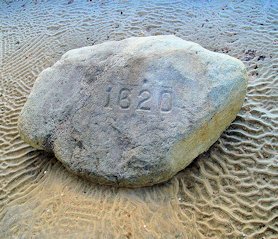
|
Some Common Myths Thought to be True - Myth 154
Myth 154: In 1622 the Pilgrims Landed in Plymouth Harbor on Plymouth Rock
Plymouth Rock is an American icon, a symbol of intrepid discovery, liberty, and
freedom of conscience. The stone itself is granite, probably from a formation
known as the Dedham granite, formed 608 million years ago (give or take 17
million years) - that is, a long time before 1620!
|
| Plymouth Rock | |
|
Nature did havoc to the Rock, but humans did worse, chipping off small pieces
for patriotic souvenirs, taking large pieces to put on display to build
patriotic fervor, even using it as part of a wharf at one time. In 1774, 20
yoke of oxen came to move Plymouth Rock, and it split in the process. Half of
the Rock was put on display at Pilgrim Hall Museum from 1834 to 1867, but was
then brought back here.
|
|
| ⇦ Back to Myth 153 Return to Myth Choices Page 11 On to Myth 155 ⇨ | |